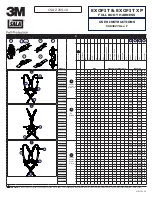
test can be considered complete. Record
the total testing time for subsequent
analyses.
Another type of sieve analysis is the wet
sieve test. In this method, the sample is
weighed and then washed through the
finest sieve in the stack with water, a
wetting agent (water based), or some
other compatible solvent. After thoroughly
washing the fines from the raw sample, the
residue is dried either over a hot plate or in
an oven. The temperature of the sieve
should be maintained below 149°C
(300°F)
1
to avoid loosening of the sieve
cloth or failure of the solder joint. After
drying, the residue is then sieved normally
on the balance of the sieve stack. The loss
in weight not accounted for on the coarse
screens is assumed to be fines or soluble
material.
Wet sieve analysis is especially helpful
when working with naturally agglomerated
materials, ultra-fine powders with severe
static changes and in samples where fine
particles tend to cling to the coarse
fractions in the blend. The disadvantages
associated with wet sieving are primarily
the time period required to perform the
analysis due to the additional washing and
drying time and the possible damage to the
sieve mesh by overloading. A common
practice with wet sieving operations is
brushing or forcing the sample through the
mesh while the liquid medium is directed
on the sieve. This pressure can distort the
sieve openings or tear the mesh at the
solder joint through stress. Therefore, this
procedure is not recommended. Once the
sieving interval is complete, whether dry or
wet sieving is used, the residue on each
sieve is removed by pouring the residue
into a suitable weighing vessel. To remove
material wedged in the sieve’s openings,
the sieve is inverted over a sheet of paper
or suitable collector and the underside of
the wire cloth brushed gently with a nylon
paint brush with bristles cut to a 25.4 mm
(1”) length. The side of the sieve frame
may be tapped gently with the handle of
the brush to dislodge the particles between
brush strokes. At no time should a needle
or other sharp object be used to remove
the particles lodged in the wire cloth.
1
Advantech metal framed sieves should not exceed 261° F
(127° C). Solder will begin to soften at this point.
Special care should be taken when
brushing sieves finer than 80 mesh.
Brushing can cause distortions and
irregularities in the sieve openings. The
procedure is repeated for each sieve in the
stack and contents of the pan.
The individual weights retained on the
sieves should be added and compared to
the starting sample weight. Wide variations
or sample losses should be determined
immediately. If the finished sample weight
varies more than 2% from the initial
weight, the analysis and sample should be
discarded and the test performed another
sample. If the sample weights are
acceptable, complete the calculations and
report the individual weights retained on
each sieve.
Presentation and analysis of the
resulting data is frequently made easier by
plotting on one of a number of graph
formats. The most common graphic
presentation is the plotting of the
cumulative percentage of material retained
on a sieve (plotted on a logarithmic scale)
versus percentage (plotted on a linear
scale). The resulting curve allows a quick
approximation of the sieve size at the fifty-
percentile point of accumulation. The curve
also shows the smoothness of the
distribution by revealing the presence of
bimodal blends in the sample. Other
plotting techniques include log-log and
direct plotting of micron size versus
percentage retained.
Содержание VariSifter VS1000
Страница 2: ......
Страница 32: ......
Страница 34: ...Table 2 ...
Страница 35: ...Table 3 ...
Страница 36: ...Table 3 cont d ...
Страница 37: ...Table 4 ...
Страница 38: ...Table 5 ...
Страница 39: ...Table 6 ...
Страница 46: ......
















































